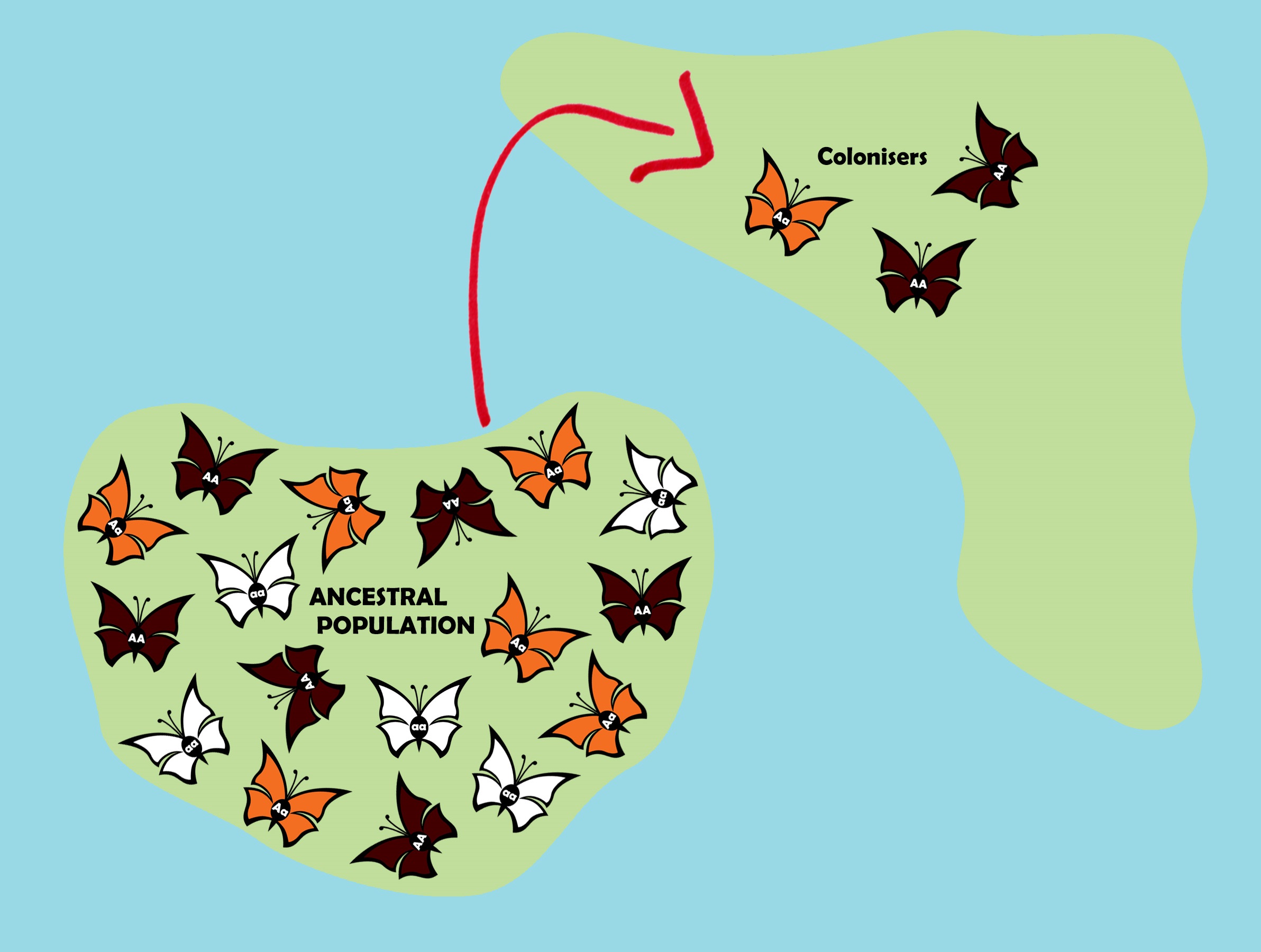Evolution (Descent with Modification)
What is Evolution and Where Did the Idea Come From?
The term “descent with modification” was a phrase Charles Darwin coined to summarize the process by which species accumulate differences from their ancestors as they adapt from different environments over time.
It can also be defined as a change in the genetic composition of a population from generation to generation.
Evolution can be viewed in 2 ways: as a pattern and as a process.
As a pattern, evolution has been shown with data as facts and is derived from the observations about the natural world and scientific disciplines like biology, geology, physics, and chemistry.
The patterns of evolution are bounded by what we know in sciences.

The process of evolution consists of the natural causes of the natural phenomena we observe.
Long before Darwin, Aristotle (384-322 BCE) viewed species as fixed (unchanging).
He thought that each form of life is perfect and permanent.
The ideas on the origin of life were generally consistent and based off of the Old Testament account of creation.
Many 18th century scientists found it remarkable that organisms are well suited for life in their environment as evidence that the Creator has designed each species for a specific purpose.
Carolus Linnaeus (1707-1778), was a Swedish physician/botanists that saw life’s diversity as “for the greater glory of God.”
Darwin’s idea of evolution took inspiration from the study of fossils, called paleontology.
Fossils in a specific layer of rock (strata) could provide a glimpse of some of the organisms that lived on Earth at the time that layer formed.

French biologist Jean-Baptiste de Lamarck (1744-1829) proposed a mechanism for how life changes over time.
His first principle was use and disuse, the idea that parts of the body that are used extensively become larger and stronger, while those that are not used deteriorate.
His example was a giraffe stretching its neck to reach leaves on high branches.
The second principle was inheritance of acquired characteristics, saying that an organism can pass these modifications to its offspring.
Lamarck reasoned that many generations of giraffes stretched their necks even higher.
However, this idea is rejected by modern scientists, as bonsai trees can be “trained” to grow through pruning and shaping, but its offspring would be of normal size.
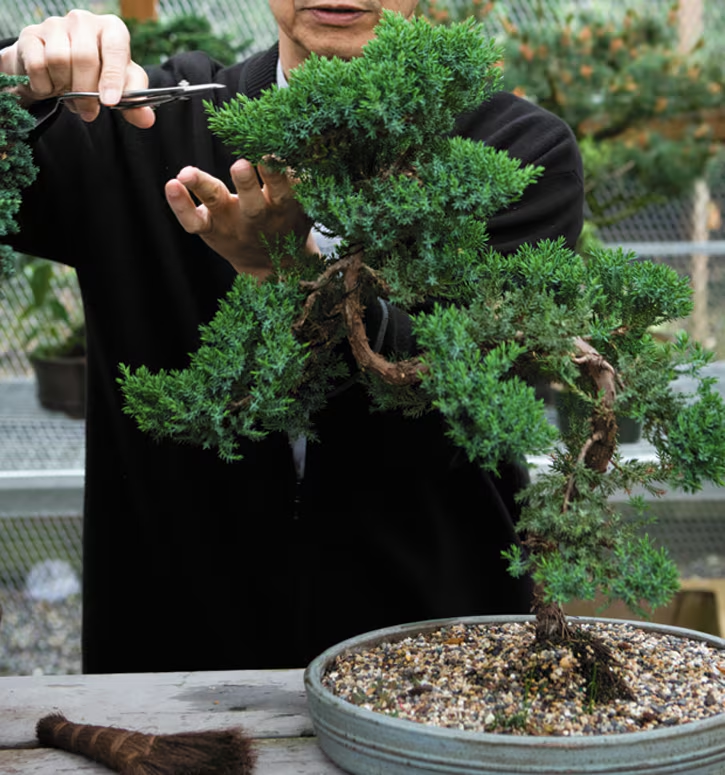
Lamarck also thought that evolution happened b/c organisms have an innate drive to become more complex.
Darwin rejected this idea.
On Darwin’s voyage from England on the Beagle, he landed on the Galapagos near South America.
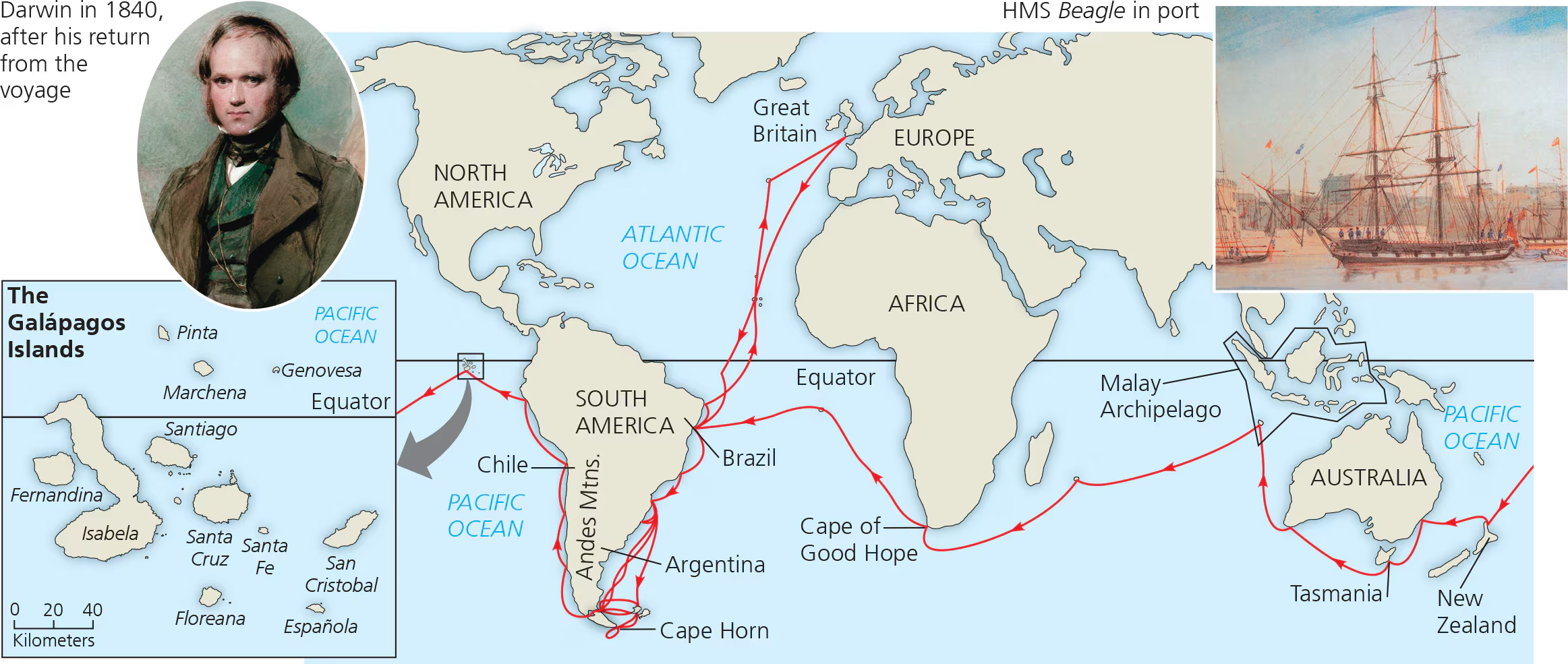
He collected different kinds of mockingbirds, as saw that although they were similar to each other, each seemed to be a different species.
Some were unique to individual islands, while others lived on two or more adjacent islands.
Darwin hypothesized that the Galapagos had been colonized by organisms that had strayed from South America and then diversified, giving rise to new species on the various islands.
At the islands, he observed examples of adaptations, inherited characteristics of organisms that enhance their survival and reproduction in specific environments.
He also observed finches.
It was noted that the finches’ various beaks and behaviors are adapted to the specific foods available on their home islands.

He realized that explaining such adaptations was essential to understanding evolution.
His explanation of how adaptations arise centered on natural selection, a process in which individuals that have certain inherited traits tend to survive and reproduce at higher rates than do other individuals because of those traits.
When he proposed the idea of natural selection, he was met with a lot of skepticism.
To draw similarities and prove his point, he pointed how humans have modified other species over many generations by selecting and breeding individuals that possess desired traits, a process called artificial selection.
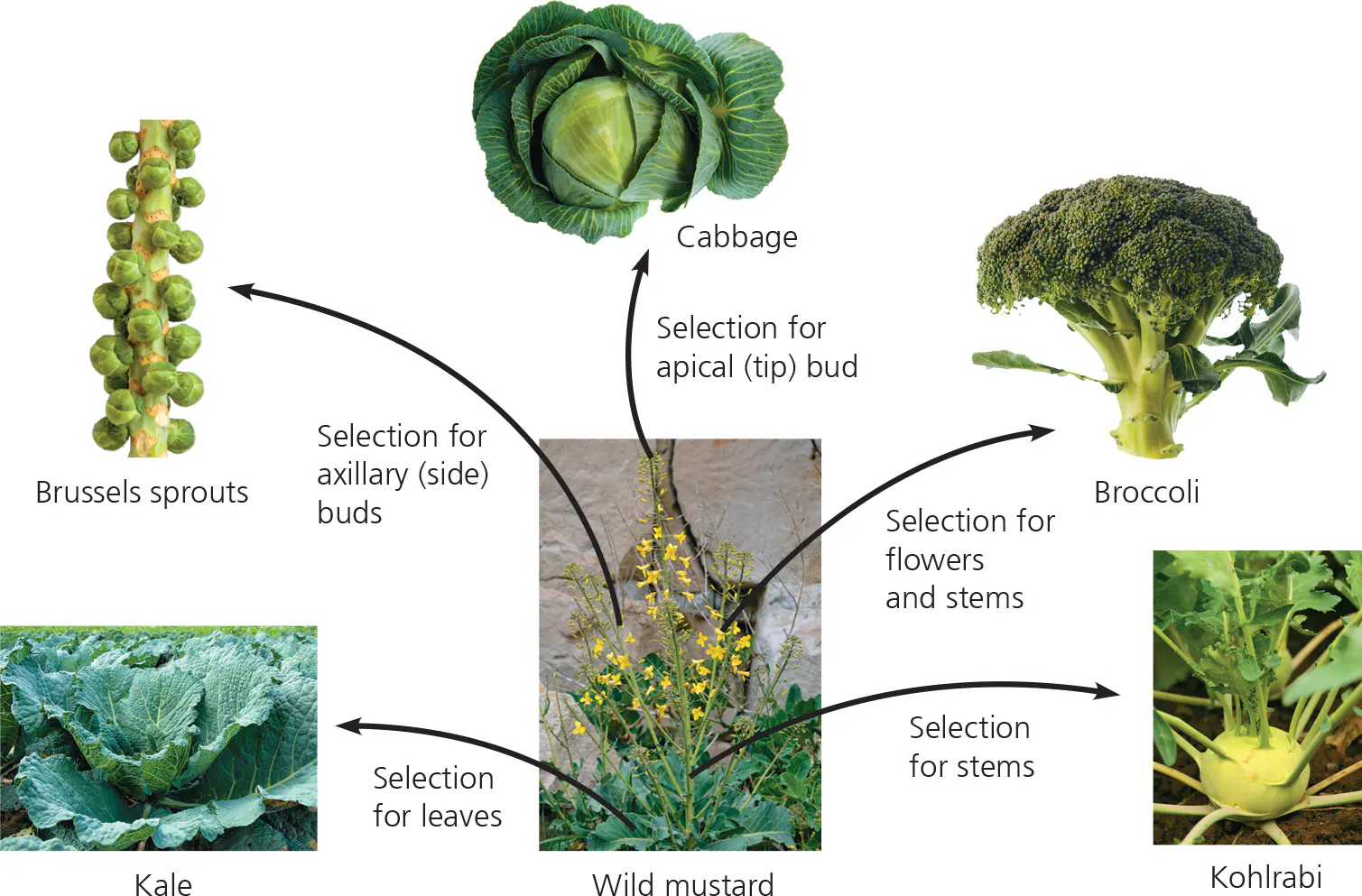
He had two observations on which he drew two inferences on.
Observation #1: Members of a population often vary in their inherited traits.
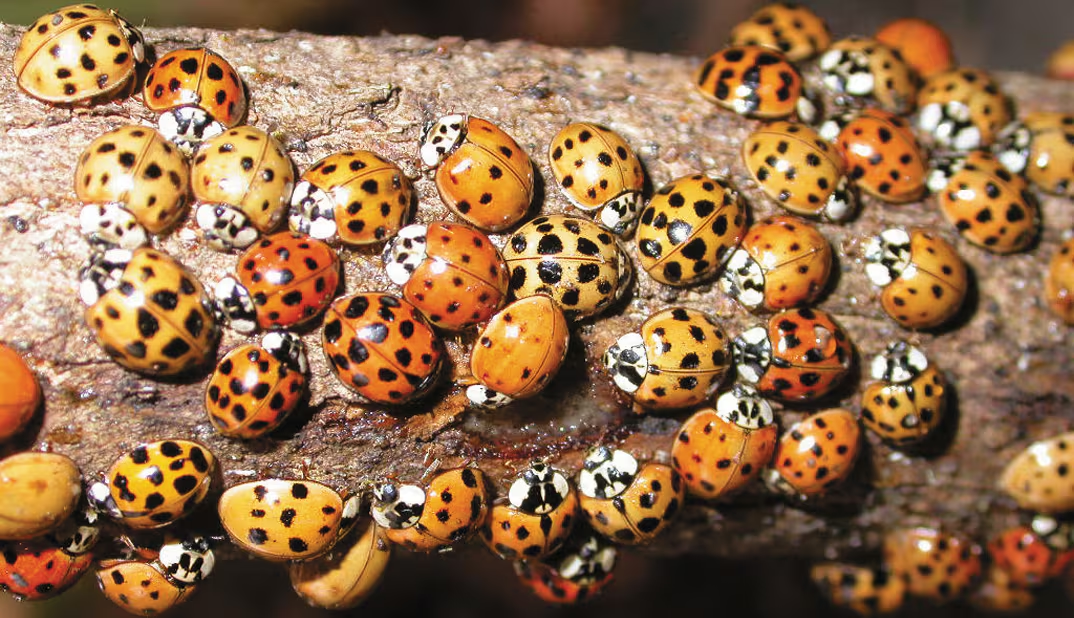
Observation #2: All species can produce more offspring than their environment can support (overpopulation) and many of these offspring fail to survive and reproduce.
Inference #1: Individuals whose inherited traits give them a higher probability of surviving and reproducing in a given environment tend to leave more offspring than do other individuals.
Inference #2: This unequal ability of individuals to survive and reproduce will lead to the accumulation of favorable traits in the population over generations.

As these inferences suggest, Darwin saw an important connection between natural selection and the capacity of organisms to “overreproduce”.
He saw that this capacity to overreproduce exists in all species.
Of the many eggs laid, young born, and seeds spread, only a tiny fraction complete their development and leave offspring of their own.
The rest are eaten, starved, diseased, unmated, or unable to tolerate physical conditions of the environment.

An organism’s heritable traits can influence not only its own performance, but also how well its offspring cope with environmental challenges.
An organism might have a trait that gives its offspring an advantage in escaping predators, obtaining food, or toleration physical conditions.
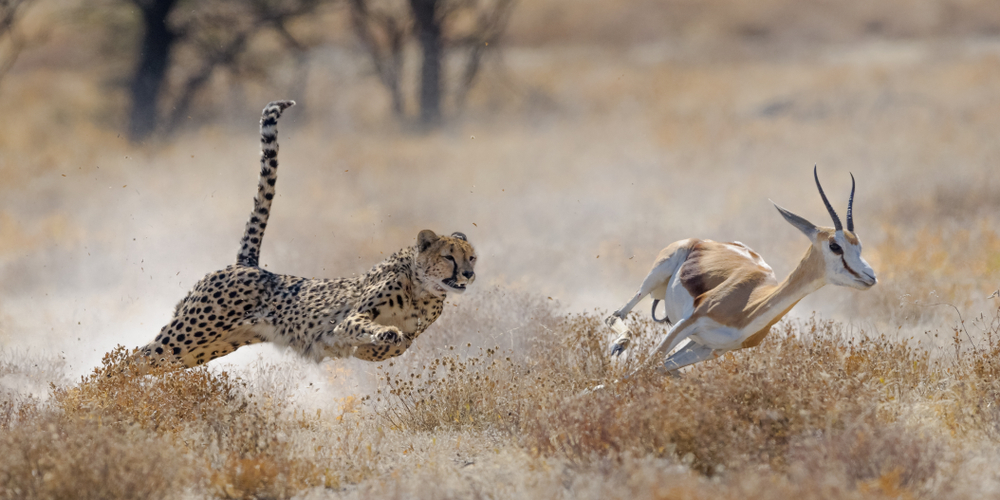
When such advantages increase the number of offspring that survive and reproduce, the traits that are favored will likely appear at a greater frequency in the next generation.
Thus, over time, natural selection resulting from factors such as predators, lack of food, or adverse physical conditions can lead to an increase in the proportion of favorable traits in a population.

Key Points:
Natural selection is a process in which individuals that have certain heritable traits survive and reproduce at a higher rate than do other individuals because of those traits.
Over time, natural selection can increase the frequency of adaptations that are favorable in a given environment.
If an environment changes, or if individuals move to a new environment, natural selection may result in adaptation to those new conditions, sometimes giving rise to new species.
Although natural selection occurs through interactions between individual organisms and their environment, individuals do not evolve.
It is the population that evolves over time.

Natural selection can amplify or diminish only those heritable traits that differ among the individuals in a population.
Even if a trait is heritable, if all the individuals in a population are genetically identical for that trait, evolution by natural selection cannot occur.
Environmental factors vary from place to place and over time.
A trait that is favorable in one place or time might be useless/detrimental in other places or times.
Natural selection is always operating, but which traits are favored depends on the context in which a species lives and mates.
How has the Idea of Evolution Changed Today?
In the last 150 years, new discoveries have filled many of the gaps that Darwin identified.
There are 4 types of data that document the pattern of evolution and illuminate how it occurs: direct observations, homology, the fossil record, and biogeography.
Direct observation is observing evolution that happens in real time, like bacteria quickly evolving resistances to antibiotics.
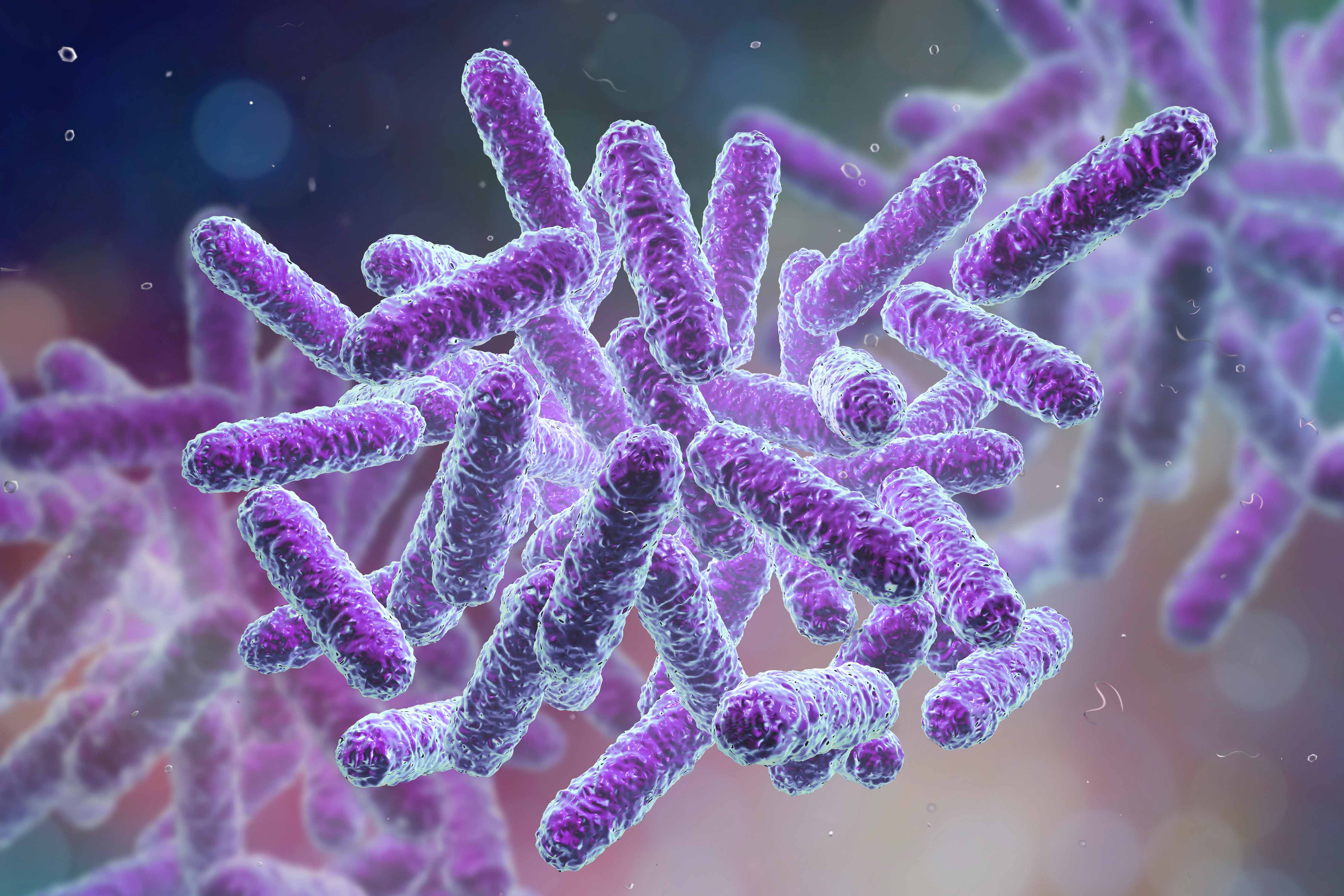
Homology is similarities in structure, genes, or development between different species that share a common ancestor.
Homologous structures are structures in different species that are similar b/c of common ancestry
Vestigial structures are structures that are “left over” from ancestors that no longer serve a purpose
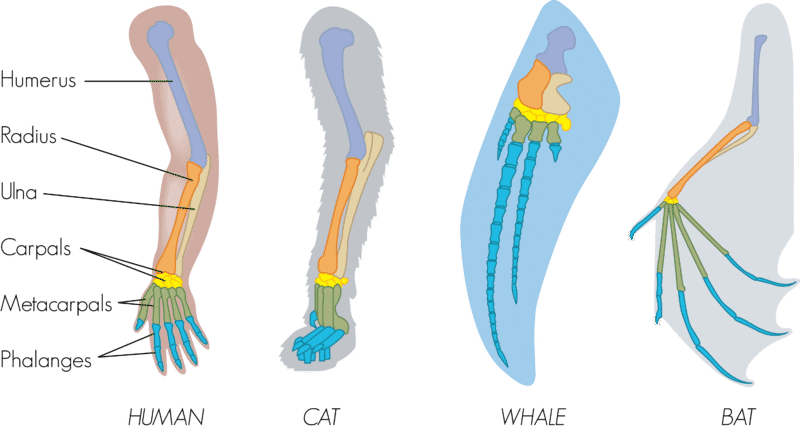
Fossil record is studying of past organisms’ fossils and observing their changes over time.
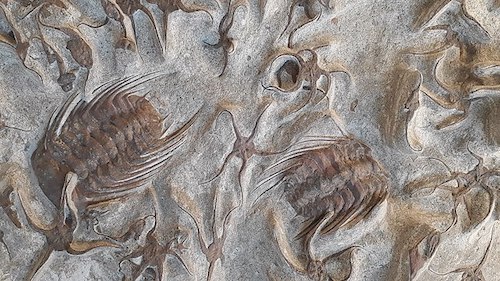
Biogeography is the way species are distributed across the planet that shows how they spread out over time.
Sometimes, organisms can have similar features even if they are not common ancestors and evolve independently from one another.
This is called convergent evolution.
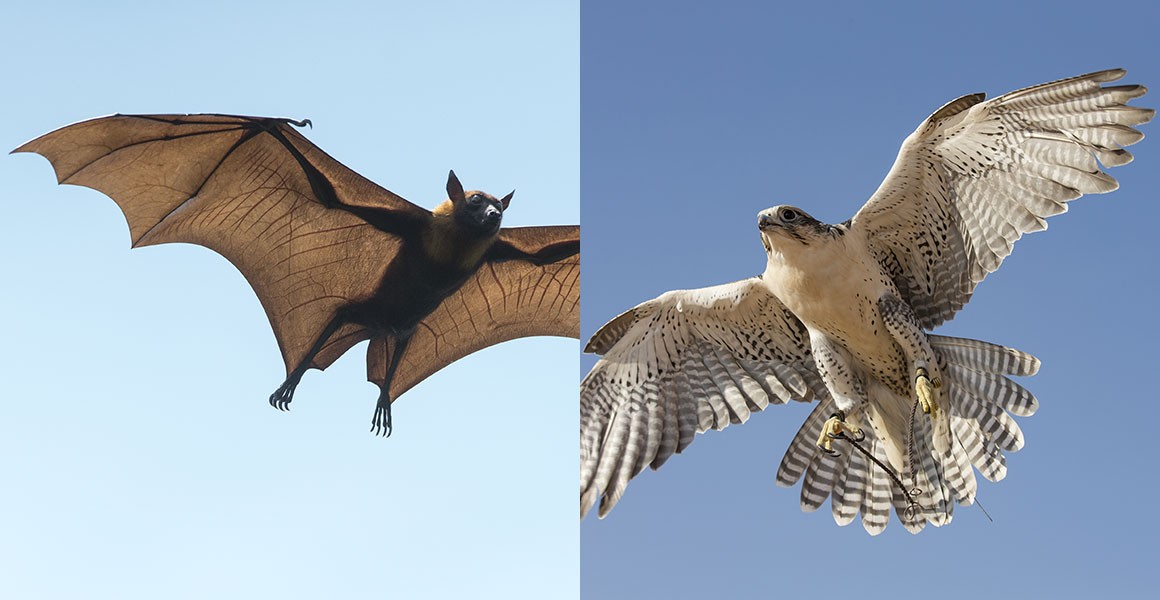
Structures that are similar due to convergent evolution is said to be analogous.
How Small can Evolution Be?
There is a misconception that individual organisms evolve.
Although it is true that natural selection acts on individuals: each organism’s traits affect its survival/reproductive success compared to other individual.
But the evolutionary impact of natural selection is only apparent in how a population of organisms change over time.
Focus on evolutionary change in populations, evolution on the smallest scale is called microevolution.
It is the change in allele frequencies in a population over generations.
There are three things that causes changes in allele frequencies: natural selection, genetic drift, and gene flow.
Natural selection is the process by which organisms with traits better suited to their environment survive and reproduce more successfully, passing those traits to the next generation.
Genetic drift are chance events that can cause unpredictable fluctuations in allele frequencies.
There are 2 types: Bottleneck effect and Founder effect.
The bottleneck effect is when the size of population is reduced by a sudden event.
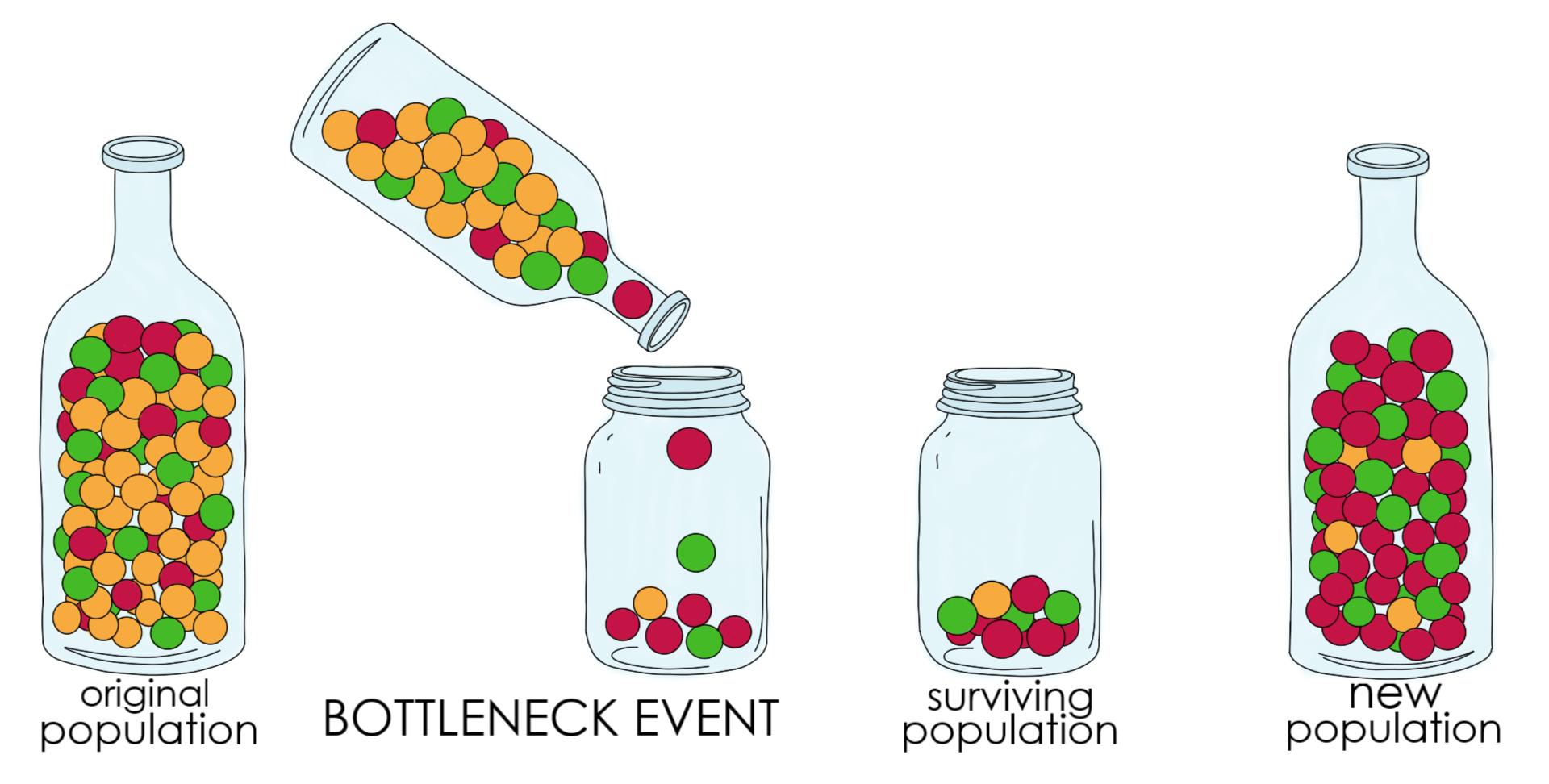
The founder effect is when a few individuals become isolated from a larger population and forms a new population whose gene pool differs from the original.
Key points about genetic drift:
Genetic drift is significant in small populations.
Genetic drift can cause allele frequencies to change at random.
It can lead to a loss of genetic variation within populations.
Can cause harmful alleles to become fixed.
Gene flow is the transfer of alleles into or out of a population due to the movement of fertile individuals or their gametes.
An example is the wind carrying a flower’s pollen to another flower far away. These two flowers have different alleles.
It can transfer alleles that improve the ability of populations to adapt to local conditions.
It increases genetic variation.

What Contributes to Genetic Variation?
Genetic variation is defined as differences among individuals in the composition of their genes or other DNA sequences.
Genetic variation at the whole-gene level is called gene variability.
Genetic variation at the molecular level of DNA is called nucleotide variability.

Many nucleotide variations occur within introns (noncoding segments of DNA) lying between exons (regions retained in mRNA after RNA processing).
Genetic variation originates when mutation, gene duplication, or other processes produce new alleles and new genes.
Sexual reproduction also results in genetic variation as arranging existing genes in new ways.

New alleles can arise from mutation, a change in the nucleotide sequence of an organism’s DNA.
Mutations can be caused by things like errors in DNA replication, exposure to radiation (like UV light), and exposure to certain chemicals.
Although most mutations are harmful, some are not.
Mutations in noncoding regions result in neutral variation, differences in DNA sequence that do not result in a disadvantage or advantage.
Even if there is a point mutation that is on a coding region but does not change the amino acid’s composition, then it has no affect on the protein’s function.
changes in the amino acid might not even affect the protein’s shape/function in some cases.
What is the Hardy-Weinberg Equation?
Just because individuals within a population might be genetically different from one another, it does not guarantee that said population will evolve.
A population is a group of individuals of the same species that live in the same area and interbred, producing fertile offspring.
A population’s genetic makeup is its gene pool, which consists of all copies of every type of allele at every locus in all members of the population.
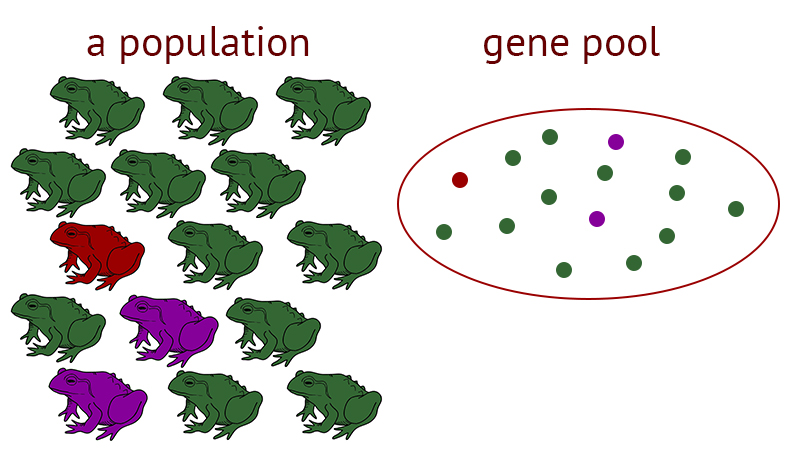
If only one allele exists for a particular locus in a population, that allele is fixed in the gene pool.
Hardy-Weinberg equilibrium is when a population is not evolving and the allele & genotype frequencies remain constant from generation to generation.
It’s a model used to see whether natural selection or other factors are causing evolution.
It states that the frequencies of alleles and genotypes in a population will remain constant from generation to generation.
Shows that only Mendelian segregation and recombination of alleles are at work.
There are 5 conditions a population must meet to be at HW equilibrium:
No mutations
If not true, gene pool is then modified and alleles are altered, leading to genetic variation and possibly new traits/adaptations.
Random mating
If not true, certain genotypes can be favored or favored against. Can lead to some alleles becoming more common and some less common, changing allele frequencies.
No natural selection
If not true, some traits will provide an advantage and over time, advantageous traits will become more and more common.
Extremely large population size
Has to be large enough to withstand random events. If not true (small population), random events like genetic drift can dramatically alter allele frequencies.
No gene flow
If not true, individuals migrating into a population might introduce new alleles or those leaving might remove certain alleles, changing allele frequencies.

What are Different Types of Natural Selections?
Natural selection can alter the frequency of distribution of heritable traits in a couple of ways.
First way is directional selection, which is when conditions favor individuals exhibiting one extreme of a phenotypic range.
This shifts a population’s frequency curve for a phenotypic character in one direction or the other.
This is common when a population’s environment changes or when members of a population migrate to a new habitat.

Disruptive selection is when conditions favor individuals at both extremes of a phenotypic range over those with intermediate phenotypes.
Shifts a population’s frequency to both ends a direction, leaving a dip in the middle.
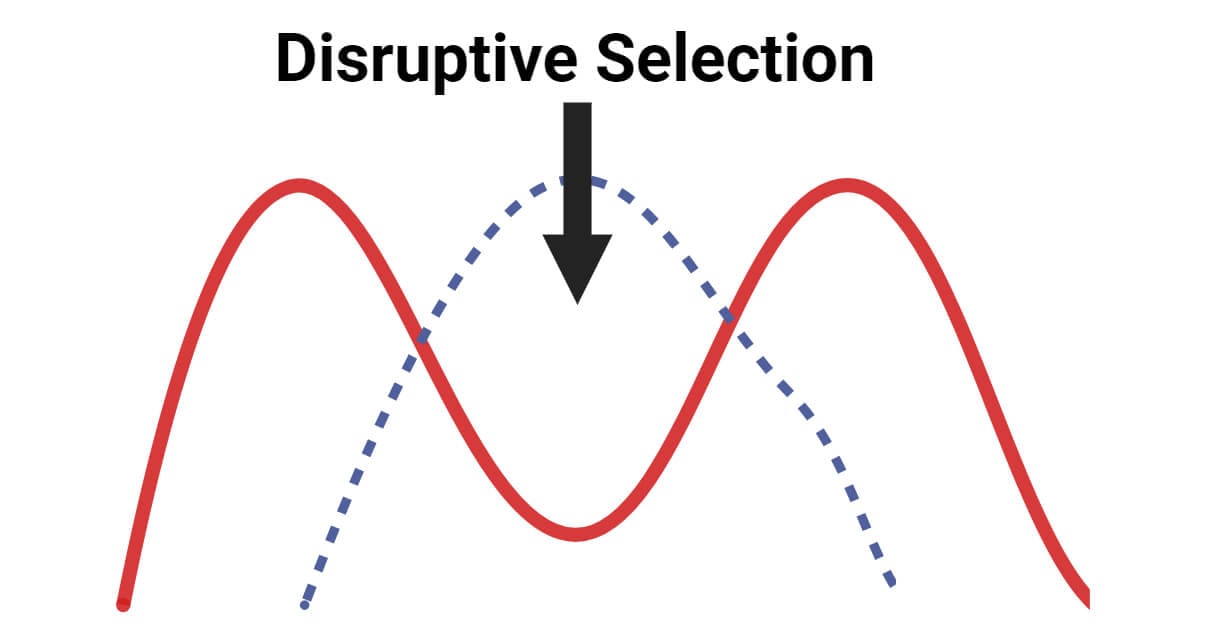
Stabilizing selection is when conditions favor intermediate phenotypes over extreme phenotypes.
This acts against both extreme phenotypes.
Stabilizing selection reduced variation and tends to maintain the status quo for a particular phenotypic character.
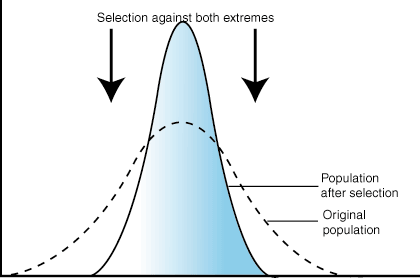
Sometimes in natural selection, it may preserve variation at some loci, thus maintaining two or more phenotypic forms in a population.
Known as balancing selection, this includes heterozygote advantage and frequency-dependent selection.
Heterozygote advantage is when heterozygous individuals at a particular locus have greater fitness than do both kinds of homozygotes.
In this case, natural selection maintains two or more alleles at that locus.
It could result in stabilizing or directional selection, depending on the relationship between genotype and phenotype.
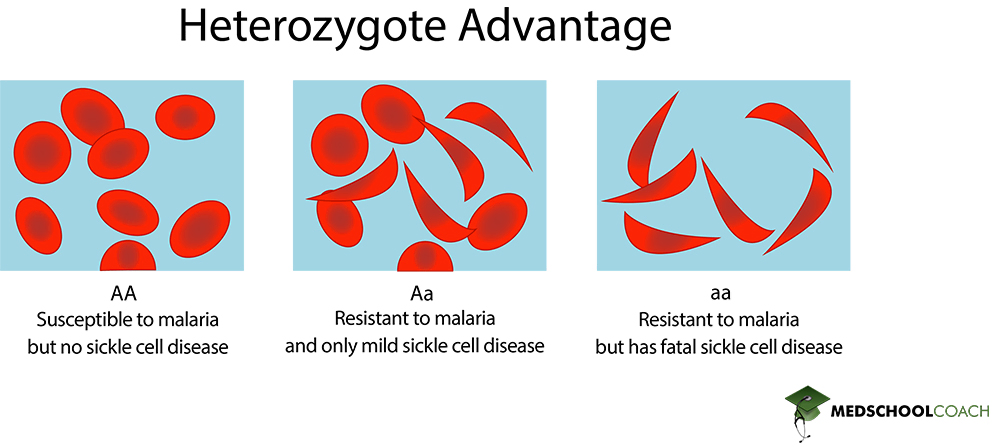
In frequency-dependent selection, the fitness of a phenotype depends on how common it is in the population.
An example is prey species that evolve to look toxic/dangerous, and some predators are more likely to avoid common colors or patterns.

Sexual selection is a process in which individuals with certain inherited characteristics are more likely than other individuals of the same sex to obtain mates.
It can result in sexual dimorphism, a difference in secondary sexual characteristics between males and females of the same species.
Could differ in size, color, ornamentation, and behavior.
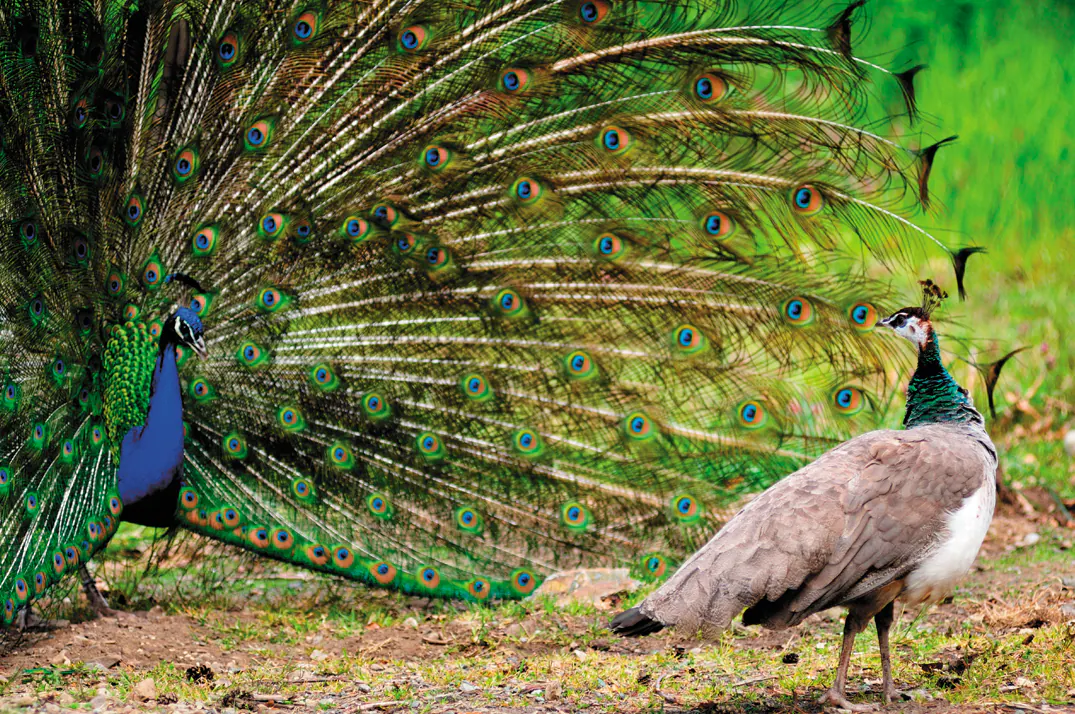
In intrasexual selection, which is selection within the same sex, individuals of one sex compete directly for mates of opposite sex.
Mostly occurs among males.

In intersexual selection, which is mate choice, individuals of one sex are choosy in selecting their mates from the other sex.
Usually females are the individuals who choose.
Mostly depends on the other’s appearance or behavior.

However, it might make a species like male birds more visible to predators.
But if such characteristics helps them gain a mate and the benefits outweighs the risk of predation, then it would increase overall reproductive success.
Why Can’t Natural Selection Make Perfect Organisms?
Selection can only act on existing variations, meaning only fittest phenotypes that are currently within a population.
These may not be the most ideal traits.
New advantageous alleles do not arise on demand.
It is limited by historical constraints, meaning each species has a legacy of descent with modifications from ancestral forms.
Evolution cannot scrap ancestral anatomy and build new complex ones from scratch.
Like a land animal suddenly having wings to fly is impossible.
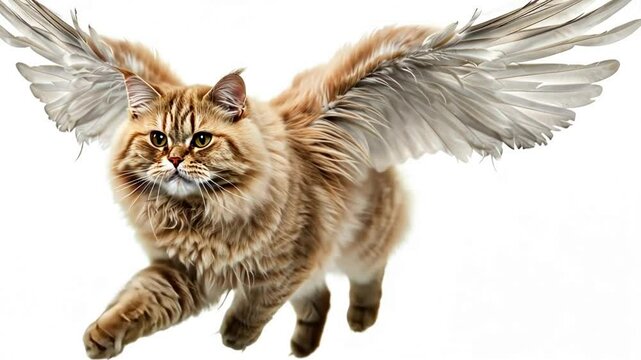
Evolution only operates on the traits an organism already has.
Adaptations are often compromises.
As organisms develop different traits, they might lose or give up old ones.
They face trade-offs in which the ability to perform one function may reduce the ability to perform another.
Like seals gaining legs to walk but losing flippers so they cannot swim nearly as well.

Chance, natural selection, and the environment interact.
Change events can affect the evolutionary history of populations.
Like a founder effect can move individuals to a new environment where their traits are not best suited.
The environment at a particular location may change unpredictably from year to year.
Because of these four constraints, evolution does not result in perfect organisms.
Natural selection operates on a “better than” basis.
Evolution will definitely result in many imperfections of organisms it produces.
Where did Species Originate From?
When Charles Darwin came to the Galapagos Islands, there was a mystery that captivated him.
This “mystery of mysteries” was speciation, the process by which one species splits into two species.
Later on, he realized that speciation explained how species share many characteristics.

Speciation draws comparison between microevolution and macroevolution.
Microevolution was changes over time in allele frequencies in a population.
Macroevolution is the broad pattern of evolution above the species level.
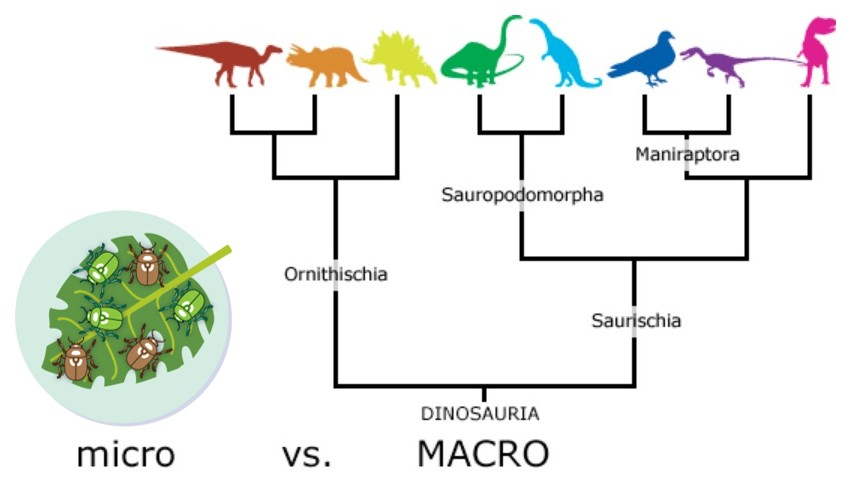
In daily life, we usually distinguish between various “kinds” of organisms based on differences in appearance.
But biologists compare not only the morphology (body form) of different group of organisms but also their physiology, biochemistry, and DNA sequences.
Results show that morphologically distinct species are indeed discrete groups.
A species is defined by a group of populations whose members have the potential to interbreed in nature and produce viable, fertile offspring.
But cannot produce viable, fertile offspring with members of other such groups.
Therefore, members of a species must be reproductively compatible.
The formation of a new species hinges on reproductive isolation.
The existence of biological factors (barriers) that impede members of two species from interbreeding and producing viable, fertile offspring.

These barriers block gene flow between species and limit the formation of hybrids, offspring that result from an interspecific mating.
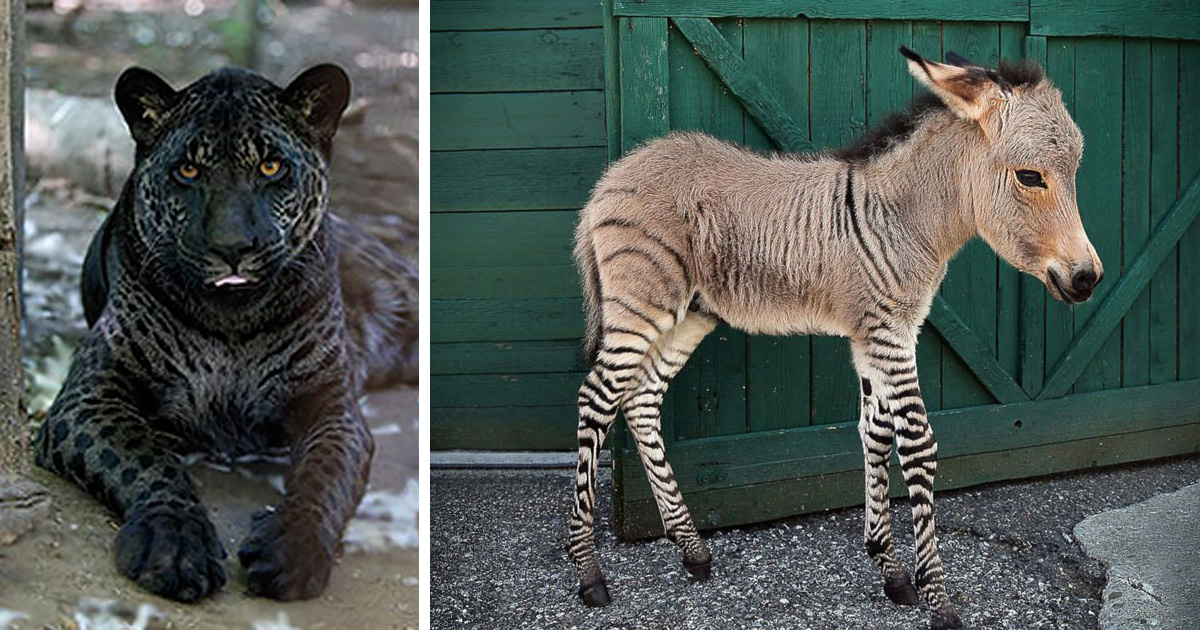
These barriers can be classified according to whether they contribute to reproductive isolation before or after fertilization.
Prezygotic barriers (“before the zygote”) block fertilization from occurring.
They can impede members of different species from attempting to mate.
Preventing an attempted mating from being completed successfully.
Hindering fertilization if mating is completed successfully.
There are five types of prezygotic barriers:
Habitat isolation is when species live in different areas or occupy different habitats within the same area.
Temporal isolation is when species breed at different times of the day, year, or season.
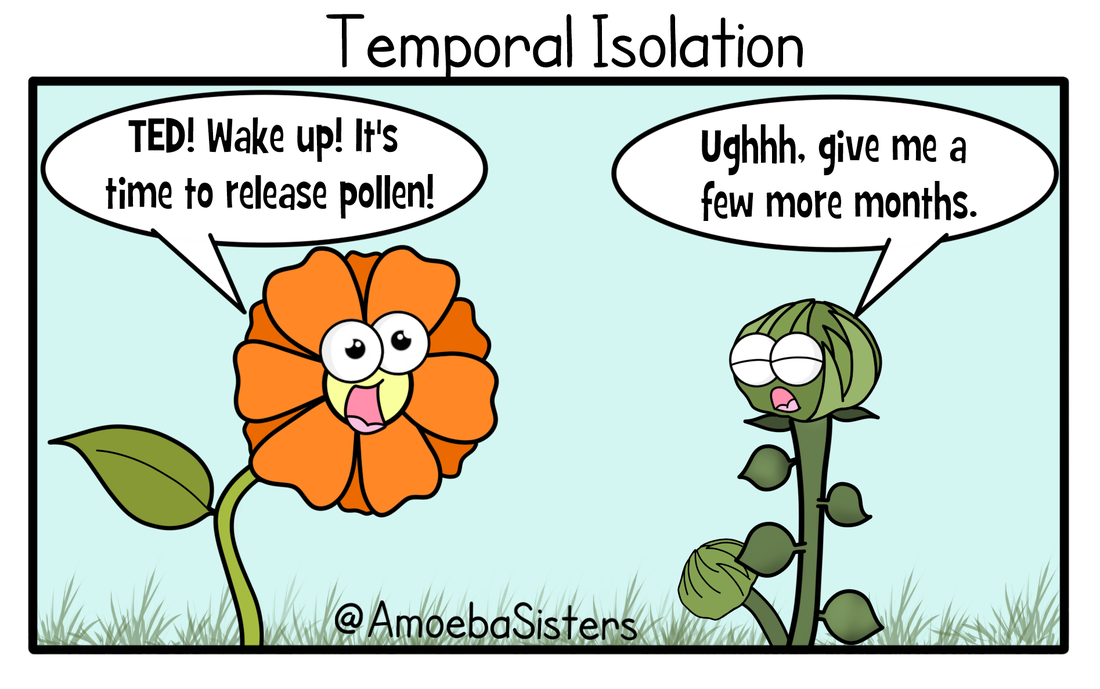
Behavioral isolation is when unique behavioral patterns and rituals separate species.

Mechanical isolation is when the reproductive anatomy of one species does not fit with the anatomy of another species.

Gametic isolation is when proteins on the surface of gametes do not allow for the egg and sperm to fuse.

However, if the sperm cell overcomes prezygotic barriers and fertilizes an ovum from another species, a variety of postzygotic barriers (“after the zygote”) may contribute to reproductive isolation after the hybrid zygote is formed.
There are three types of postzygotic barriers:
Reduced hybrid viability is when the hybrid zygote/offspring fails to develop properly or reach maturity.

Reduced hybrid fertility is when the hybrid offspring matures but is infertile and cannot produce offspring of its own.

Hybrid breakdown is when hybrid offspring is viable and fertile in the first generation, but their offspring (next gen.) are inviable or sterile.

Another way to define species is through the morphological species concept.
This distinguishes a species by body shape and other structural features.
A disadvantage of this is that it relies in subjective criteria.
The ecological species concept defines a species in terms of its ecological niche.
Which is the sum of how members of the species interact with the nonliving and living parts of their environments.
Over the years, there has been a few hypotheses about how species arise from existing species.
In allopatric speciation (“other country”), gene flow is interrupted when a population is divided into geographically isolated subpopulations.
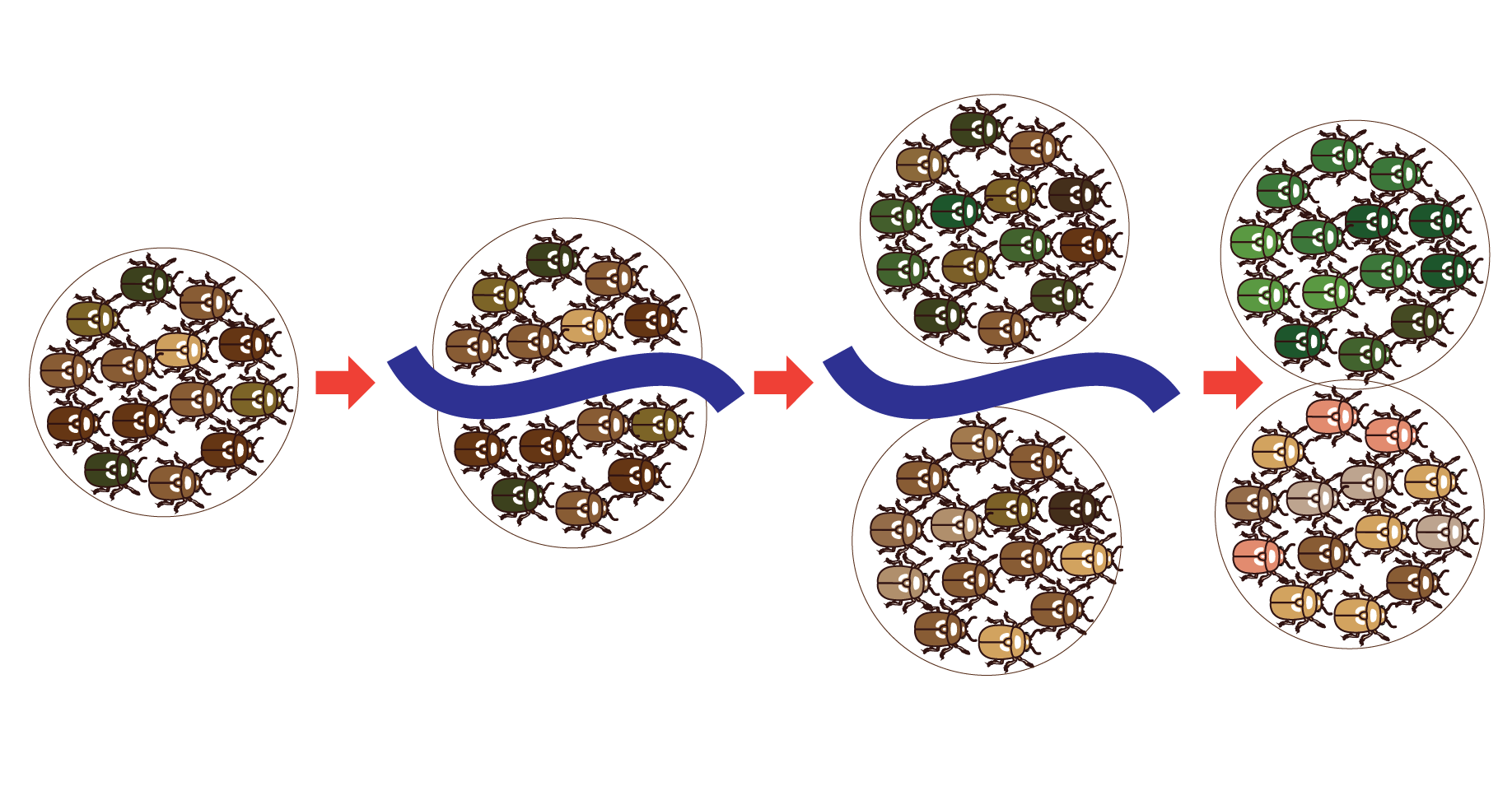
The barriers by which species are separated in allopatric speciation depends on the ability of the organisms to move about.
Once geographic isolation has occurred, the separated gene pools may diverge.
Different mutations arise, and natural selection and genetic drift may alter allele frequencies.
Reproductive isolation may then evolve as a by-product.
In sympatric speciation (“same country”), speciation occurs in populations that live in the same geographic area.
Although contact makes sympatric speciation uncommon, it can still occur if gene flow is reduced by different factors.
These factors include polyploidy, habitat differentiation, and sexual selection.
A condition called polyploidy is when there is a chromosomal alteration in which the organisms possesses more than two complete chromosome sets.
This results from an accident of cell division.
Although this can happen in animals, it’s much more common in plants.
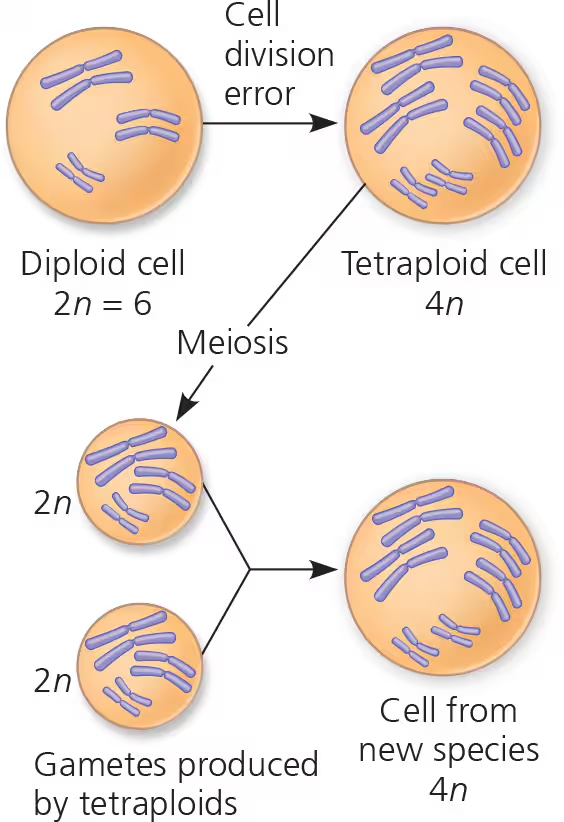
There are two distinct forms of polyploidy.
An autopolyploid is an individual that has more than two chromosome sets that are all derived from a single species.
An allopolyploid is a fertile individual that has more than two chromosome sets as a result of two different species interbreeding and combining their chromosomes.

Scientists have hypothesized different paces/tempos by which evolution and speciation occurs.
Punctuated equilibrium is when evolution occurs rapidly after a long period of stasis.
Gradualism is when evolution occurs slowly over hundreds, thousands, or millions of years.

